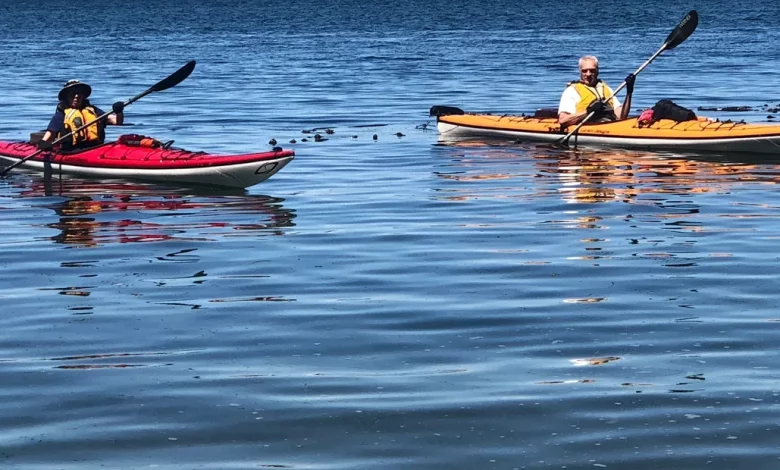Exploring Kayak Cartography: Mapping Your Adventures

In the vast world of kayaking, the blend of technology and exploration has given rise to a fascinating aspect Kayak Cartography. This article aims to be your comprehensive guide, diving into the depths of what kayak cartography is, its evolution, and the indispensable role it plays in mapping your adventurous escapades.
When you embark on a kayaking journey, having a robust understanding of kayak cartography can transform your experience from a simple paddle on the water to a well-planned and documented adventure. So, let’s paddle into the intricate waters of kayak cartography and unravel the mysteries that lie beneath the surface.
Understanding Kayak Cartography
A. What is Kayak Cartography?
Kayak Cartography is the art and science of creating maps specifically tailored for kayakers. It involves the use of various tools and technologies to map routes, mark points of interest, and ensure a safe and enjoyable paddling experience. The evolution of kayak cartography has closely followed advancements in navigation and mapping technologies, from traditional paper maps to modern GPS devices and smartphone apps.
Tools and Equipment
GPS Devices:
Global Positioning System (GPS) devices are essential tools for kayak cartography. They provide real-time location data, helping kayakers navigate waterways with precision.
Smartphone Apps:
Dedicated kayak navigation apps offer features like offline maps, route planning, and live tracking. Apps like Navionics and Paddle Logger have become popular among kayakers.
Traditional Maps:
While modern technology prevails, traditional paper maps should not be overlooked. They serve as reliable backups, especially in areas with poor connectivity.
Choosing the Right Tool:
The selection of a mapping tool depends on factors like water conditions, connectivity, and personal preference. Each tool has its advantages, and kayakers should choose based on their specific needs.
Benefits of Mapping Your Kayak Adventures
A. Safety
Navigation and Route Planning:
Accurate mapping enhances navigation, enabling kayakers to plan routes, avoid hazards, and ensure a safe journey. GPS devices provide real-time updates, reducing the risk of getting lost.
Emergency Situations:
In unforeseen circumstances, mapped routes become invaluable. Kayakers can share their precise location with rescue teams, expediting assistance in emergencies.
Record Keeping
Tracking Progress:
Kayak cartography allows enthusiasts to track their progress over time. This record-keeping aspect adds a sense of accomplishment and motivates paddlers to explore new routes.
Documenting Points of Interest:
Mapping tools enable kayakers to mark interesting locations, wildlife sightings, or notable landmarks. This documentation transforms each journey into a personalized adventure log.
Sharing Experiences
Social Media Integration:
Many mapping tools allow users to share their routes and experiences on social media. This not only fosters a sense of community but also inspires fellow kayakers to explore new routes.
Creating a Kayak Adventure Journal:
Mapped routes can be integrated into a kayak adventure journal, complete with photos and anecdotes. This not only preserves memories but also serves as a valuable resource for future trips.
How to Get Started with Kayak Cartography
Setting Up Your Equipment
Calibrating GPS Devices:
Before embarking on your kayak adventure, it’s crucial to calibrate your GPS device. This ensures accurate positioning and enhances the overall effectiveness of the mapping tool.
Installing and Configuring Apps:
For smartphone apps, proper installation and configuration are essential. This includes setting up offline maps, adjusting tracking preferences, and ensuring the app is synchronized with your kayak journey.
Choosing the Right Maps
Online vs. Offline Maps:
Consider the availability of internet connectivity in your kayaking location. Offline maps are crucial for areas with limited or no network coverage, providing uninterrupted access to mapping information.
Topographical vs. Nautical Maps:
Depending on your kayaking environment, choose between topographical maps for inland waters or nautical charts for coastal or open sea adventures. Understanding the differences ensures you have the right map for your specific journey.
Understanding Symbols and Markings
Common Symbols on Maps:
Familiarize yourself with common symbols used in kayak cartography. Symbols represent various features such as docks, campsites, and potential hazards. Understanding these symbols enhances your ability to interpret maps accurately.
Interpreting Contour Lines:
Contour lines on topographical maps illustrate changes in elevation. This information is vital for understanding the terrain, identifying potential challenges, and planning your route effectively.
Tips for Effective Kayak Mapping
Planning Your Route
Factors to Consider:
Take into account factors such as water conditions, weather forecasts, and your skill level when planning a kayaking route. These considerations help ensure a safe and enjoyable journey.
Adjusting for Weather Conditions:
Stay informed about weather conditions and be prepared to adjust your route accordingly. High winds, strong currents, or sudden storms can impact your kayaking experience, and having a flexible plan is key.
Real-time Tracking
Using GPS to Stay on Course:
Utilize real-time tracking features on your GPS device or app to stay on course. This helps you navigate efficiently, especially in larger bodies of water where visual landmarks may be limited.
Monitoring Speed and Distance:
Many mapping tools provide information on your speed and the distance covered. Monitoring these metrics not only adds a layer of safety but also allows you to gauge your performance and set goals for future trips.
Saving and Sharing Routes
Saving Waypoints:
Save important waypoints during your journey. These could be entry and exit points, interesting landmarks, or potential campsites. This ensures you can revisit or share your favorite routes in the future.
Sharing Maps with Fellow Kayakers:
Collaborate with other kayakers by sharing your mapped routes. This not only fosters a sense of community but also introduces you to new and exciting kayaking locations suggested by fellow enthusiasts.
Overcoming Challenges in Kayak Cartography
Limited Connectivity
Offline Mapping Strategies:
In areas with limited connectivity, offline mapping is crucial. Download maps in advance and ensure your mapping tool allows for seamless navigation without relying on constant internet access.
Using Cached Maps:
Some mapping apps allow users to cache maps, storing them temporarily for offline use. This feature ensures that even without a live internet connection, kayakers can access previously downloaded maps.
Battery Life Management
Energy-Saving Techniques:
Prolong the battery life of your devices by implementing energy-saving techniques. Lower screen brightness, close unnecessary background apps, and carry portable chargers to ensure your mapping tools remain operational throughout your journey.
Portable Charging Solutions:
Invest in portable charging solutions, such as solar chargers or power banks, to keep your devices powered during extended kayak trips. Being proactive about battery management ensures that you won’t be left without your essential mapping tools.
Case Studies: Successful Kayak Cartography Stories
Personal Experiences
Lessons Learned:
Share personal experiences of using kayak cartography, emphasizing the lessons learned during different journeys. Real-life stories add a practical dimension to the benefits and challenges discussed earlier.
Memorable Adventures:
Highlight memorable adventures made possible through effective kayak cartography. Showcase how mapping tools have enhanced the overall experience, from discovering hidden coves to navigating challenging waterways.
Future Trends in Kayak Cartography
Technological Advancements
Augmented Reality in Mapping:
Explore the potential integration of augmented reality (AR) in kayak cartography. AR can overlay digital information onto the physical environment, providing an immersive navigation experience for kayakers.
Integration with Smart Kayak Systems:
Discuss the evolving integration of kayak cartography with smart kayak systems. This could include real-time data from sensors on the kayak, further enhancing safety and navigation capabilities.
Conclusion
In conclusion, exploring kayak cartography opens up a world of possibilities for paddlers. From ensuring safety to documenting memorable experiences, the use of mapping tools significantly enriches the kayaking adventure. As technology continues to advance, so does the potential for even more exciting developments in the realm of kayak cartography.
As you embark on your next kayak journey, consider the invaluable role that cartography plays in enhancing both the practical and emotional aspects of your adventure. Embrace the technological tools available, learn from the experiences of others, and let kayak cartography be your trusted companion on the water.








